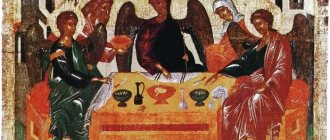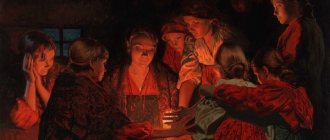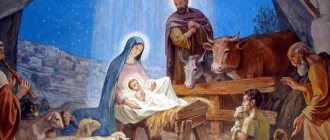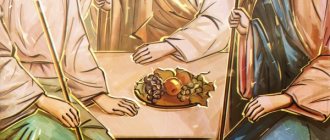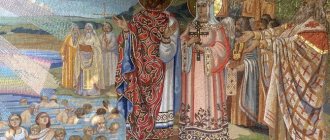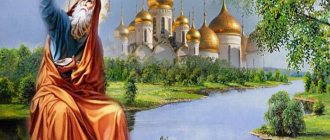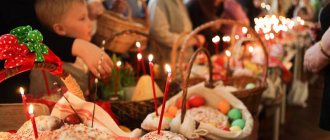history of the holiday
The event was established in memory of the baptism of Jesus Christ in the Jordan River by John the Baptist. During the life of the Savior, only adults who were able to experience religion and faith in God were baptized (Jesus was baptized at the age of 30).
The holiday received the name “Epiphany” because the Holy Trinity appeared during the sacrament of baptism of the Savior. The Holy Spirit descended on Jesus Christ in the form of a white dove and the heavenly voice of the Father, which proclaimed him the Son of God.
Congratulations on the holiday of Epiphany + pictures
It’s not difficult to choose the best congratulations in pictures on Epiphany for your family and friends. We recommend viewing the following gallery. She will help you choose the appropriate postcard. Pay attention to the options with ready-made wishes in poetry and prose. Remember that the main thing is attention and you need to be able to show it correctly.
Send some of your warmth along with a beautiful image by writing a few beautiful lines from yourself. You can save congratulations in the form of pictures to your smartphone, and then send them to your friends in instant messengers or through social networks. The image should have something symbolizing the holiday: a temple, a font, angels.
Traditions and rituals of the holiday
At Epiphany, people attend services where they perform the sacrament of communion with Epiphany water. On the night of January 19, churches hold an all-night vigil, which turns into the morning liturgy. People bring holy water home and sprinkle it in the corners of rooms to protect their homes and family members from evil spirits.
On the night of January 19, it is customary to make wishes.
How to make a wish for Epiphany
On the holiday, families gather around a lush table filled with various delicacies. There is no post on January 19th.
Baptism ends the period of Christmas caroling and fortune telling. On this day, people remove New Year's and Christmas decorations and hide them until next year. Housewives collect the hay that was placed under the tablecloth at Christmas and give it to their pets.
An important attribute of the holiday is swimming in an ice hole.
About the true place of the Baptism of Jesus Christ, the Jordanian saints and the “bishop without a pulpit”
In November 2021, I was lucky enough to immerse myself in the waters of the Jordan River when pilgrims and I, traveling around Jordan, lived at the Compound in honor of St. John the Baptist at the site of the Baptism of the Lord. Hegumen Mikhei (Selyakov), the acting clergyman of the Compound of the Russian Ecclesiastical Mission at the site of the Baptism of Jesus Christ, talks about the Russian pilgrimage residence of the highest level and much more.
Compound of the Russian Spiritual Mission in Jordan
– Father Micah, how did you end up in the Jordan Archaeological Reserve called “The Place of the Baptism of Christ”?
– I think this is God’s Providence. I didn't specifically ask for it. It so happened that I had to leave Siberia for health reasons. And it didn’t matter to me which southern country I would be sent to. I relied on the will of God: as Bishop Anthony determines, so be it. He is the head of the Moscow Patriarchate Office for Foreign Institutions, Metropolitan of Korsun and Western Europe. He, however, asked where I wanted to serve: in a parish with children or somewhere else... I replied that every monk wants to be closer to the monastic environment. And the bishop said that there was a vacancy in Jordan. Of course, I immediately agreed, and for about a year I have been working in the Russian Hospice House at the site of the Baptism of Jesus Christ.
I think this is God's providence
When I think about the most important events in Biblical history that took place here, it takes my breath away, and I can’t believe that I am serving in such a holy place. It is called Bethavara, which means “crossing” in Hebrew. In ancient times, there was a crossing over the Jordan River.
– How long ago did this place become a pilgrimage site?
– Russian pilgrims began visiting this place back in the 12th century, but now not all Russians know about it. While reading a historical book about Jordan, I realized that each village here is associated with a specific biblical event. It was here that the Israelites, after forty years of wandering in the desert, crossed the then flooded Jordan into the Promised Land under the leadership of Joshua.
Jordan River in winter 2019
Over the course of seven centuries, from the 5th to the beginning of the 12th century, five Christian churches replaced each other at the site of the Epiphany. The first temple was built under the Byzantine Emperor Anastasia, on special arches at a height of 6 meters above the ground. This was done so that the temple would not be destroyed during the floods of the Jordan.
Mosaic icon at the site of Baptism
– What historical evidence suggests this?
– In the 1990s, an international group of archaeologists discovered the stone skeleton of the chapel during excavations. She stood in the place where the Lord took off his vestments before entering the water. In the nearby city of Madaba (this is the biblical Medeva), which is inhabited mainly by Christians, at the end of the 19th century, the Basilica of the Holy Great Martyr George the Victorious was built on the basis of an ancient Christian temple. A unique ancient mosaic map of the holy places of Palestine has been preserved on the floor of the basilica. It dates back to the 6th century AD. It was this map that suggested where to look for the historical place of the Baptism of our Lord Jesus Christ from the right hand of St. John the Baptist. The site was marked by the base of a Greek column, which was discovered along with the ruins of a Byzantine church. The remains of an ancient font and basilica are preserved at a distance of several hundred meters from the Russian Hospice House. Just think about it - you and I are walking in the very places where St. John the Baptist preached, where Jesus Christ, who received Baptism from his hand, called the apostles from among his disciples! Jesus Christ returned to this same place, “beyond the Jordan,” when the Jews decided to kill Him at the feast of renewal.
Ancient temple on the site of Baptism
Just think about it - you and I are walking in the very places where St. John the Baptist preached
– Where do pilgrims most often come to you from?
– Most are from Russia, and most of them are from Moscow. There were people from Krasnodar and Chelyabinsk, but 90% were probably Muscovites. Foreigners come, but they are literally only a few.
– Mostly Orthodox?
- Not only. Last winter, for three or four days, the Anglicans held some kind of theological debate. Tables were set up for them in the hall, we even talked and discussed with them. They prayed, of course, separately, on the street.
- Did they know that a five-minute walk from the hotel there is a convenient descent to the river, where pilgrims bathe in the sacred waters of the Jordan - in the place where Jesus Christ Himself received Baptism?
– Diving into water is more of a Russian tradition. I didn't see any foreigners swimming. I myself take a dip every day in the summer, mostly in the evening when no one is there. In addition to pilgrims, tourists from Aqaba also come here. Thank God, many of them are believers and baptized. That is, this place performs a missionary function, despite the fact that they do not attend divine services.
“As soon as we got off the bus, we immediately ran to the Jordan River to have time to take a dip before dark. Do all pilgrimage groups behave this way?
- Majority. Now here is the most convenient place to dive into the Jordan. About three years ago everything was improved here. We made an oak bath and a descent to the water. Previously, the bottom was clay, but now wooden steps lead into the depths. The descent to the river is located very close to the residence.
Hill of the Prophet Elijah and the site of the cave of the Prophet John the Baptist
– In the Holy Land, like nowhere else, you can feel the closeness of the saints. In your Church of John the Baptist there is a large icon of the “Cathedral of Jordanian Saints.” Most of their names are unknown to me, unfortunately.
– This icon, of course, does not depict all the Jordanian saints, but only the main ones who labored here. Among the widely known are, first of all, the prophets Elijah and John the Baptist and the Venerable Mary of Egypt. Two kilometers from the Hospice House there is the hill of the Holy Prophet Elijah. Here he crossed the Jordan before the Lord took him to heaven in a chariot of fire. The guides will show you the Tel Harrar hill with the ruins of a Byzantine cave church. It is revered as the home of the prophet Elijah and John the Baptist. Orthodox Christians cannot help but visit the site of the beheading of John the Baptist. According to legend, he was imprisoned in the town of Makavir - in the dungeon of the castle of King Herod Machairos. Here the feast described in the Gospel took place in honor of Herod’s birthday, during which John the Baptist was beheaded by the sword. In the year 72 A.D. The Romans left no stone unturned of Herod's castle, but biblical ruins to this day testify to the events that took place here.
Russian Church of John the Baptist at the site of Baptism
Biblical ruins to this day testify to the events that took place here.
Not far from us is the place of the exploits of the Venerable Mary of Egypt, who crossed the Jordan to go into the desert for ascetic labors and repentance. It's literally about three hundred meters from here. In Great Lent, on the day of the “Standing of the Venerable Mary of Egypt,” we read her life and the canon of Andrew of Crete right in the place in the desert where the Venerable Mary of Egypt lived. In Jordan, holy places are preserved in an inclusive, pristine form - there are no modern tiles or lanterns. We see everything as it was during the times of the Jordanian saints: the same bushes and the same sand - the situation that was here several centuries ago.
– Our wonderful missionary guide Alexander Frel showed us both the source of St. John the Baptist and the ruins of a Byzantine monastery at the supposed site of the feat of St. Mary of Egypt. He also said that various Christian denominations now have their own churches and monasteries in the reserve. But the Orthodox feel at home, of course, in the very cozy Russian Hospice House. What is the history of its creation?
– In July 2006, King Abdullah II Bin Al-Hussein of Jordan decided to provide Russia with land on the territory of the “Place of the Baptism of Jesus Christ” reserve for the construction of a pilgrimage center. In February 2007, a summit meeting between the King of Jordan and Russian President Vladimir Putin took place. A plot of land in Bethawara was officially transferred to Russia by the government of the Kingdom of Jordan for indefinite and free use. In March of the following year, the foundation stone of the future complex was consecrated on the eastern bank of the Jordan. On June 26, 2012, as part of the official visit of the President of Russia to Israel, the “Russian Hospice House at the site of the Epiphany” was inaugurated. From that time on, he entered the infrastructure of the oldest Russian institution in the Holy Land - the Russian Spiritual Mission in Jerusalem, which has been receiving pilgrims for more than 170 years.
Patriarch Kirill, 2012
– Which famous people visited you?
– Patriarch Kirill visited the hospice house on the site of the Epiphany in November 2012 during his official visit to the Holy Land. This happened a month after the arrival of the first group of pilgrims. He toured the Church of St. John the Baptist, a pilgrim residence designed for 98 people, cozy hotel rooms with all amenities, a spacious refectory, car parking, two descents to the Jordan: one of them is convenient for small groups, the second for large ones. And on October 6, 2015, the Hospice House was visited by the Chairman of the Federation Council Valentina Matvienko, Ambassador to Jordan Boris Bolotin, senators, State Duma deputies, politicians and businessmen of Russia and Jordan. They were met by representatives of the clergy led by the head of the Russian Ecclesiastical Mission in Jerusalem, Archimandrite Alexander (Elisov).
“We were struck by its beauty by the Orthodox church in honor of St. John the Baptist located on the second floor of the Hospice House. This is the heart of the pilgrimage residence. I didn’t want to leave the temple for a long time.
– All pilgrims admire our temple, painted in the Byzantine style. It is open daily until late in the evening. Divine services in the temple are held on Wednesdays, Fridays, Sundays and on major holidays. Pilgrims order remembrances of health and repose for six months and a year. Rarely does anyone leave a church shop without icons or souvenirs. Even Catholics often come in groups on excursions to our church. Everyone notes its splendor, special silence and tranquility.
– What are your own feelings from being in Jordan?
– These inner feelings cannot be expressed in words. This is a feeling of a Holy place and a special closeness to the saints, to God. It seems that every prayer, every thought you have is heard. We know, of course, that the Lord is very close to each of us, but here, sometimes, you don’t even pray, but just think - and the Lord already gives what you ask for.
Hotel
– Do you provide care to the local population?
“My first priority is to take care of hundreds of pilgrims. I also have to provide spiritual care for local Russian-speaking Christians. Thank God that at the seminary I was the chairman of the missionary brotherhood, so I gained some experience, which was very useful here. About three times a week we pray for repose. When there is no liturgy, I serve a prayer service and funeral litia. Notes are mainly submitted by visitors. If they order magpie, we pray for about three months, because... We have 3-4 liturgies a week. Local Orthodox Christians are like confessors here. After all, the country is Muslim - they have their own laws. As they say, the East is a delicate matter. Many parishioners have Muslim husbands, and we try to pay more attention to them, and the requirements for them are no longer as strict as in an Orthodox country. When they talk about their faith, you see how the Lord helps them, how the hand of God is with them, what miracles happen in their lives at their request. This is from their personal stories about their lives, about how they came to faith.
– Are there many parishioners?
– Compared to Tyumen, where we had quite a lot of parishioners (from 700 to 1000 people came for Easter), here, of course, there are much fewer. In Tyumen, in the Holy Trinity Monastery, the short distance from the cell to the temple would take about 40 minutes, because there were a lot of people and they asked a lot of questions. Sometimes I thought about how to get to the temple, sometimes I started hiding. And here you expect and value every person. You pay much more attention to everyone, especially our local parishioners.
– Do you feel the closeness of the saints in this holy place?
- Yes. I can tell you one case. During the festive all-night vigil, I go out in front of the royal doors to read prayers during the sixth psalm; accordingly, no one remains in the altar. In the altar there were prosphora lying on the altar, from which I had already begun to remove particles for forties. I still had one prosphora left - not taken out, untouched. I come in about 10 minutes later, look, and no less than a hundred particles have been taken out of the prosphora. There is no one, I am the only priest, I have neither a sexton nor a deacon here. Only the reader on the choir read the psalms.
I come in about 10 minutes later, look, and no less than a hundred particles have been taken out of the prosphora. There is no one, I am the only priest
– And who, in your opinion, took out the particles?
– Many people talk about St. Nektarios of Aegina. He is also called the “bishop without a pulpit”, as he often visits churches. Sometimes they even see it with their own eyes. So it's most likely him. The lives of the saints describe an incident in which one of the saints appeared to a serving hieromonk and asked him to pray at the proskomedia for his deceased parents. The hieromonk says to him: “Wait, you’re a saint, you’re in heaven, and you’re asking me, a sinner, for prayers.” The saint replies: “Here you – priests – stand directly at the throne of God, here – on Earth – prayer is more important.”
– What was the most joyful thing for you when you came here?
– The most joyful thing for me is silence, warmth and tranquility. Having lived in a city monastery, where there is constant noise and a lot of people, here, in silence, you begin to control your thoughts more, to hear yourself more. At the same time, you understand that coping with yourself is not so easy. There is both a beneficial effect on the soul and a more intensified spiritual struggle. It's more obvious. This cannot be done without God's help.
– Who sings in your choir?
– Previously, the sisters from the Gornensky convent, who were heading here for obedience, sang. Now we managed to bring one singer from the Tyumen Holy Trinity Monastery.
Metropolitan Luke of Zaporozhye
– Do you have time to communicate and get to know the pilgrims?
– When receiving pilgrimage groups, I communicate more with the priests. If a group arrives without a priest, then, of course, I take on the mission of talking and confessing. The time of communication with parishioners is usually the sermon after the liturgy. I liked one Moscow confessor, an old priest, I don’t remember his name now, but he was an example for me. He talked with his pilgrims all day long - both in the refectory, and in the evening near the fountain, and during the day they sat reading the Psalter. That is, communication continued all day long! And recently, Metropolitan Luke of Zaporozhye came with a large group of pilgrims. While they lived here, he served the liturgy every day. There were 11 accompanying priests with him.
– Russian women work in the refectory. Are these working women?
- Yes, working women. They are invited to the working season - from about mid-August to mid-June next year, because in mid-June the air temperature here rises to 50 degrees, and there are no pilgrims here for two months. You can, of course, come, swim, go to the temple. This is one of the lowest places on the planet - 400 meters below sea level (to be exact, in my opinion, 385 meters). Compared to Jerusalem, it is always 10 degrees warmer here. I usually joke that they won’t send me any lower, because there’s nowhere to go.
– How do you manage to serve without helpers at Christmas and Easter, when large numbers of people gather?
– It’s especially difficult on Easter: there’s a service in the morning, then we go to the border for the Holy Fire from Jerusalem, then we prepare, change our clothes, decorate the temple, then the pilgrims arrive, and from 9 pm I start confessing to them. And at 12 am the Easter service and procession begin.
– Who decorates the temple with flowers?
- I do everything myself. Kliroshanin helps. There are not many people, you have to do everything yourself - ring the bell, clean the altar. When pilgrims come for Easter and Christmas, we are very happy, because this is really a big help. If you serve together, it’s twice as easy.
– Are there children at the services?
- Certainly. These are mainly the children of our embassy employees and parishioners. It should be noted that the children here are older. As a rule, they know more than one language. It amazes me how well children in Jordan know not only their native Arabic, but also English. And it makes me happy that they have been brought to church since childhood.
– Father Micah, please tell us about yourself. Were you born into a believing family?
– I was born in the Urals, in the small provincial town of Kushva, Sverdlovsk region. Parents are from workers. Dad worked in the mine for more than forty years. Now he is 86 years old. Mom has died. From childhood, our parents instilled faith in us - four children. I was baptized at the age of 5 in the Church of the Archangel Michael. Mom taught short prayers and always read prayers herself. In the morning, I used to wake up because my mother in the next room was praying for her children, sometimes with tears. Of course, this left its mark on my life. Thank God, the Lord saved me from some terrible sins in my youth. There was faith. Another question is that we were not completely churched.
– Where did you study and work?
– After graduating from high school, he worked for 7 years as an OPS master in the private security department of the city of Kushva. In 2001, at the direction of the Archbishop of Yekaterinburg and Verkhoturye, Vincent entered the full-time department of the Tobolsk Seminary. She was then the third in Russia in a row. The first two were in Moscow and St. Petersburg. During his studies, he served as obedience to the senior duty officer at the Peter and Paul Church in the city of Tobolsk, the chairman of the missionary brotherhood at the seminary named after the Great Martyr Demetrius of Thessalonica. In his third year he took monastic vows. I was named in honor of the Monk Micah, abbot of Radonezh. On the Annunciation of the Most Holy Theotokos in 2004, he was ordained to the rank of deacon, and exactly a year later he became a hieromonk. For two years he bore the obedience of the commandant of the bishop's house, Archbishop of Tobolsk and Tyumen Dimitry (Kapalin). He studied in absentia for a master's degree at TPDS and in Tobolsk graduated from a pedagogical institute with a major in History and Law.
– Have you wanted to become a priest since childhood?
– No, although there were thoughts, of course. My mother and I were sitting and talking. We had a New Testament, published in the 19th or even the 18th century, but it was very old. At the age of 14–15 I was able to read Church Slavonic. I didn’t understand everything, but I tried to read. Mom looks at me and says: “Maybe you should become a priest?” I say: “Which kind of priest am I?” - "Well, yes". But 10 years later, by God’s Providence, this issue was raised again.
– Were your grandparents believers?
- Yes. They had icons at home, and we, children, asked if those depicted on the icons were alive. Then there were not enough icons or literature. Mom brought some kind of brochure from the church, barely bought it, and it only spoke about the confiscation of church valuables in the 20th century. Later, for a lot of money, they barely got a Bible.
– We arrived in the Holy Land on November 2, the day of remembrance of St. Gabriel (Urgebadze). You, of course, have read that the Gospel read in childhood played a decisive role in his life. Has the Gospel meant much in your life?
- More like the whole Bible. Mom once said: “Whoever reads the Bible, God will not leave him.” You know, when you start constantly searching for the truth, you need to know where you can find the answer to some of your questions. Little by little, secretly from everyone, I began to read the Bible every day. I read it all when I was a teenager. I had this idea: if during the day I did not find an answer to my important question, then the day was in vain. And then, more or less, books by the venerable Abba Dorotheus and John Climacus began to appear in the church library. I started reading. Wow, it turns out there are answers to all my questions. I excitedly read the whole book in one evening and memorized everything word for word. The soul was so hungry. This was the greatest impetus for churching.
– Now, in the age of the Internet, finding any book is not a problem. Did you share books with your brothers in your youth?
– I would say that they began to read and become more involved in church when I had already become a monk. We went, of course, with them on pilgrimages - to Verkhoturye to the righteous Simeon, to Merkushino - but did not particularly participate in the sacraments.
Hegumen Mikhey (Selyakov)
– When did you start becoming a church member?
– When I worked as a 5th grade alarm master in the private security department. In the evenings I was on duty, doing purely technical work: when shops, cash desks, banks were closed, if something could not be closed somewhere, I had to go out and fix the problems. Our town is small, sometimes there were no applications at all. In the 1990s, there were no cell phones, no Internet, and we didn’t even have a TV in our office. I was alone in the office for 8 hours. And I really appreciated this solitude. There was a lot to think about. I understood perfectly well that I had everything in my life, all the benefits: health, good parents, an apartment, a car, I was provided with everything - what else was missing? And he came to the conclusion that the only thing missing was prayer. This became especially obvious when watching people from the window. There's an old grandfather, barely walking, drunk, grabbing the bushes, swearing very strongly. And you think: he’s about to die, he has nothing left to live. Why is this, what is this short life for? Everything is pointless.
– Was there still some kind of call from the Lord to serve?
– In the Holy Scriptures, the Lord says: “You did not choose Me, but I chose you” (John 15, 16). When a person recognizes the truth through the Holy Spirit, he walks straight ahead, without turning back. The process of churching becomes more solid. When I went to confession for the first time (it was immediately a general Confession), a firm neophyte determination immediately appeared: “I will never sin again in my life.” This determination, while perhaps prevenient grace was still at work, lasted a week, two at most. Then I got very angry at someone and shouted. “Yeah,” I think, “it’s not working.” Gradually you begin to recognize your weakness. If you want to become a saint, you won’t succeed. I had the idea of studying at a theological seminary. The rector of our church, Archpriest Dimitry Menshikov, persistently suggested that I enter the seminary. But I didn’t want to go there right away. I say: “I don’t have much experience, let me be a sexton in the parish for a year.” And this helped me learn the Charter and gain some experience. Then, in my first year at Tobolsk Seminary, liturgics and other subjects were much easier for me.
Gradually you begin to recognize your weakness. If you want to become a saint, you won’t succeed
– In the Governor's House of Tobolsk, from August 1917 to April 1918, the Royal Family was kept under arrest until their deportation to Yekaterinburg. While studying in Tobolsk, did you venerate the holy Royal Passion-Bearers, who were not yet canonized as saints?
- Yes, sure. Just this summer, my father and I visited most of the places where the Royal Family stayed, including the former governor’s house in Tobolsk. Even before the seminary, I remember we stopped at the Ascension Church in Yekaterinburg - it is located not far from the Church on the Blood. There I bought a wonderful book - letters from Tsarina Alexandra Feodorovna. How soulfully she wrote! What pure people they were! With neophyte grace, I have always admired believers, and it seemed to me that all believers are saints, and the priests and deacons in the church are, of course, saints. Both the Royal Passion-Bearers and all the other saints are of great importance to us. They certainly hear our prayers.
– How do you understand that the saints hear you?
– Once I decided to read an akathist to St. Seraphim of Sarov. I stand, read and think: “Now so many people pray to him. Well, can he hear me? Before I had time to read the akathist, I saw a bee flying in the room. I think where? We have dense double-glazed windows. And I had a small paper icon of the reverend. I looked, and a drop of peace was flowing down it. I realized that this was, after all, an answer, that the monk could hear me. And literally a week or two later they bought us tickets to Diveevo, and we went to the relics of St. Seraphim.
I had a small paper icon of the reverend. I looked, and a drop of peace was flowing down it
– Where did you serve before you came to Jordan?
– In 2006, I graduated from the seminary and was sent for obedience to the Holy Sign Abalaksky Monastery, named after the “Sign” icon of the Mother of God. I was dean there for 7 years - since March 2007. For the last year and a half, he has been acting as viceroy at the Abalak monastery. And in December 2013, on New Year’s Eve, he was appointed chairman of the Diocesan Commission for Monastery Affairs. In 2014, I was sent as abbot to the Holy Trinity Monastery in Tyumen. I did not want to leave the secluded Abalaki monastery, located in the countryside. But I had to be the governor of the Tyumen monastery for almost four and a half years. Ideally, the vicar should also be a confessor. But in reality, you have to deal with a lot of administrative duties.
– What difficulties are you experiencing now?
– Currently, our RDM compound in Jordan (the entire complex with the temple) is not registered as a religious organization, but it needs to be made a religious organization. Then there will be tax benefits and so on, and we will be able to receive our pilgrims better. But this registration depends on the Jerusalem Patriarchate. And in a holy place the devil especially tries to ruin everything, and more attacks always happen through people. Therefore, we must always maintain peace in our souls and calmness. This is also a kind of test. In such difficult conditions, a person’s spiritual growth occurs.
– When you leave, who replaces you at services?
– If I go on vacation in the summer, it’s just when no one is there. We leave during a quiet time. And throughout the year we are here almost constantly. Tomorrow I will have to go to church to perform the funeral service for the parishioner, but there is no service tomorrow.
– Have you visited all the holy places as a pilgrim?
– Almost all of them are Israeli, because I’ve been there five times on pilgrimage trips from the Tobolsk Metropolis. In Jordan, the amazing kingdom of the East, of course, I have not seen everything yet. Groups that come for two days manage to visit much more than we do in six months.
– Many pilgrims and tourists go to the Dead Sea, located at the lowest point on the earth’s surface - 400 meters below sea level. Our pilgrimage group did not go there. But we saw the ancient city of Petra, carved into the rocks by the Nabatean tribe - a real symbol of Jordan. Of the attractions, Petra is the furthest from the Hospice House.
– In 2007, Petra was included in the list of “new wonders of the world”, along with the Great Wall of China and the Roman Colosseum. The ancient Roman city of Gerasa (modern Jerash), which was once buried under massive layers of sand and clay, is also called a “museum city.” Buildings from the time of Roman rule, ancient amphitheatres, Christian basilicas, the world-famous trifecta of Hadrian's Triumphal Arch, built in 130 AD - we can see these main attractions thanks to the efforts of archaeologists. One cannot help but visit Mount Moses, which is also called Mount Nebo. According to the Bible, God's prophet Moses was commanded to lead the Jews to the Promised Land, but was not allowed to enter it. From Mount Nebo, Moses saw God's prophecy come true, and here the prophet died and was buried.
Hot Springs
- We were on this mountain. The view of the picturesque mountain passes from here is simply stunning! They say that in clear weather, Jerusalem and Amman, the capital of the Kingdom of Jordan, are perfectly visible from the top. But we didn't see it.
– In Amman there are many monuments of pre-Christian antiquity and Christian churches - basilicas of the first centuries of our era. Built during the time of Emperor Anthony Pius, the Roman theater was designed for 6 thousand spectators. It still amazes with its scale. South of Amman is the city of Madaba. The thermal mineral healing springs of Zarqa Main have been known since the times of Ancient Rome and Byzantium. According to legend, Herod the Great himself, the king of Judea, loved to plunge into life-giving waters. Here you can see thirty-meter hot waterfalls and natural baths in which it is convenient to take thermal baths, and a picturesque cave, which the hot steam rising from the springs has decorated with bizarre and unique rock paintings.
– For those who would like to come to you, tell us about the living conditions.
– The residence includes 42 standard double rooms, 2 single “suites”. For honored visitors there is a separate building with two presidential class VIP apartments. There is free Wi-Fi. Qualified staff of the complex and guides who conduct excursions around Jordan speak Russian. We can accommodate both individual pilgrims and groups. Since our pilgrimage house is part of the Russian Spiritual Mission in Jerusalem, group accommodations are arranged through the RDM pilgrimage service. All details can be found on the website www.rusdm.ru.
Bathing for Epiphany
The Orthodox Church opposed the celebration of Christmastide, during which people sinned by turning to evil spirits in rituals of disguise and fortune-telling, which had their roots in pagan times. The clergy compromised by inventing the ritual of bathing at Epiphany. To do this, an ice hole is made in natural reservoirs - a Jordan, which the priest sanctifies by lowering a cross into it. It is believed that anyone who dips into Jordan three times will be cleansed of sins. Bathing at Epiphany is gaining popularity not for the purpose of spiritual cleansing, but as a hardening process.
Bathing for Epiphany
Why did the Savior receive baptism?
By becoming the first baptized Christian, Jesus reminded all people of the importance of religious rituals for the salvation of the soul. The Messiah made it clear that there are many truths:
- baptism is the path to unity with the Creator, renunciation of the Devil and dark forces;
- having been baptized, a person gets the opportunity to join the Holy Church, to live a life pleasing to the Lord;
- only a baptized Christian can repent and receive forgiveness of sins from the Almighty.
Thanks to baptism, it is possible to receive the highest grace, which protects a person from all kinds of evil and protects him throughout his entire life’s journey. The ritual allows one to go through a spiritual birth and can only take place once in a lifetime. It becomes fundamental for all who want to devote themselves to service in the name of God.
The day when Christ was baptized has the greatest significance for all humanity. By his act, the Savior pointed to the beginning of a new era in which every believer has the opportunity to get closer to his Creator.
Properties of Epiphany water
The Orthodox Church calls Epiphany water the great Agiasma (Shrine). Agiasma is able to remain fresh and not spoil throughout the year. Parishioners bless water in churches during services. If you cannot go to church or your place of residence is far from its location, then you can prepare water from any natural body of water as Epiphany water. It is believed that on this day all water has miraculous properties.
In some regions, priests visit the homes of their parishioners and sprinkle them with the great Agiasma. This ritual helps cleanse the house of evil spirits. Epiphany water can heal from diseases. The clergy recommend taking it by the spoonful in the morning on an empty stomach with a piece of prosphora. In villages, people feed their cattle with blessed water at Epiphany. It helps them withstand Epiphany frosts, be fruitful and not get sick.
The age of Christ's baptism is the age of majority
We read in the Gospel about the age at which Jesus was baptized:
Luke 3:23
When Jesus began His ministry, he was about thirty years old.
The Lord was baptized at the same age as the Israelite became an adult. This tradition was followed for some time by the Eastern Church. When the majority of the population of Christian states became Christians, they began to baptize infants more often, because all relatives had already been baptized.
Fortune telling
On the night of Epiphany, a magical atmosphere reigns on earth. During this period, people ask higher powers to reveal the secret of the future. With the help of magical rites and rituals, they try to see future events and receive signs of fate. Good predictions inspire hope and faith in a happy future, while bad predictions should not be given much attention. The main attribute for performing fortune telling is water blessed in the church. People believe that she is endowed with magic and is able to help establish connections with heavenly forces.
Fortune telling for Epiphany
What not to do at Epiphany
On January 19, it is prohibited to store holy water in large quantities. On the holy day, you cannot quarrel, swear, lie, complain, gossip, or entertain bad thoughts. It is undesirable to engage in heavy physical labor, clean the house, wash, or cut with scissors. It is not recommended to get a haircut, manicure or pedicure, so as not to bring bad events into your destiny. You should not sew or knit, so as not to confuse your fate. It is forbidden to borrow money, otherwise the whole year will pass in debt. On this day, it is advisable not to overeat so that your thoughts remain clear. On January 19, after the end of Epiphany Eve, it is forbidden to guess.
Signs and beliefs
- If the weather is sunny and frosty on January 19, then the summer will be hot and fruitful.
- A couple who gets married on Epiphany will live a long and happy life together.
- On Epiphany night the heavens open to the requests of people. If you pray for something, your request will definitely come true.
- Anyone who is baptized on the day of Holy Epiphany will live a long and happy life.
- If a young girl goes out on Epiphany morning and meets a young guy, then she will get married this year. If the first person she meets is an elderly man, then she will be lonely all year.
January 19 is one of the main holidays of the Orthodox Church. On the night of Epiphany, people go to churches for all-night vigils, which end with the morning divine liturgy and the blessing of water. Epiphany water has miraculous powers. She is able to heal and protect from evil spirits.
When is Epiphany in 2021 in Russia
All Christian holidays are distributed over two annual cycles. The first is called mineain, or motionless. All his memorable events are confined to one date and are strictly fixed. The second is triode, or moving. The holidays related to it are attached only to the day of the week and are counted depending on the day of Easter celebration.
Fact! The "Easter limits" are 35 days. According to the new calendar, it is celebrated from April 4 to May 8.
All the most important Orthodox holidays are called “twelfths” (perhaps because there are 12 of them) and are celebrated on the same day every year. These include Epiphany, which according to the new calendar is celebrated on January 19.

